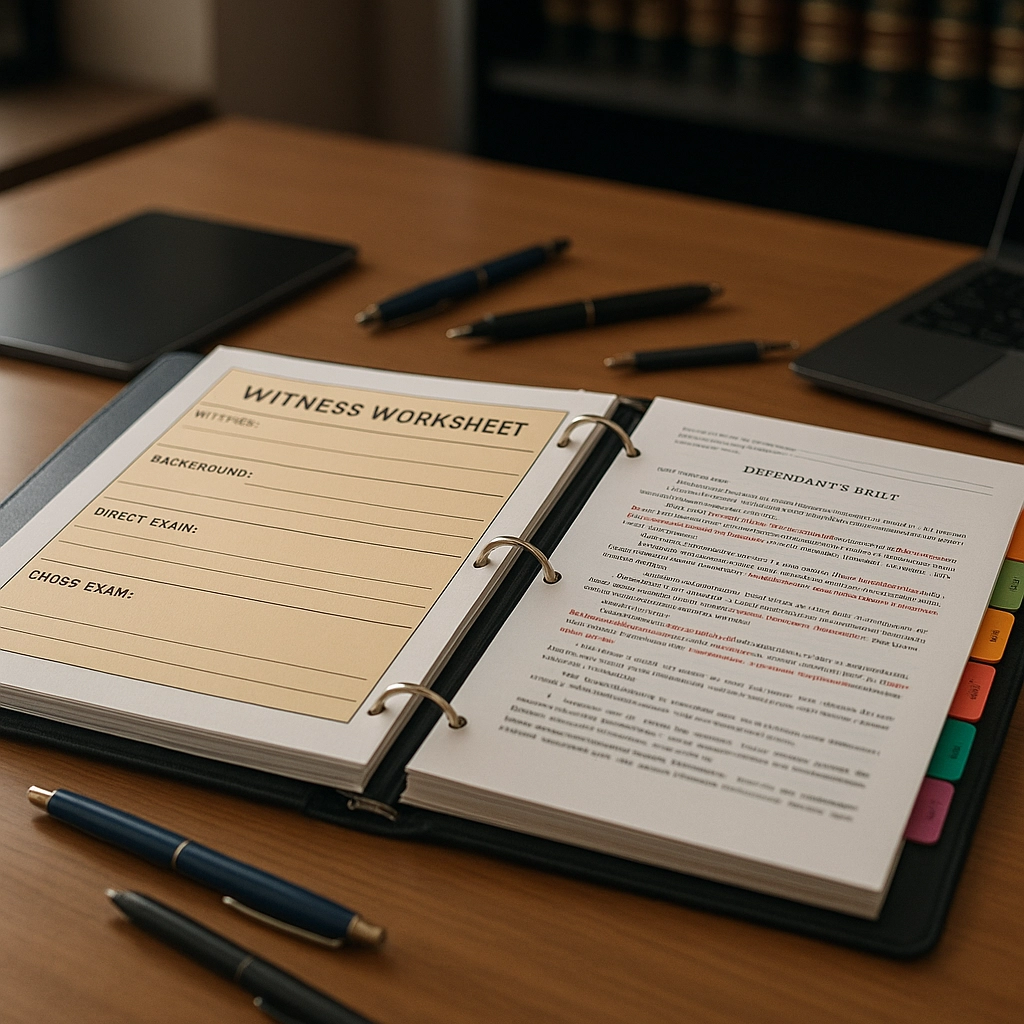The Power of Preparation: Why Cross-Examination Demands a System
When the judge calls, “Cross-examination?”—those few seconds of silence before you rise can feel like a lifetime. That’s when your preparation (or lack thereof) truly shows. Ask any trial lawyer: having a rock-solid system for organizing your attack is non-negotiable. This is where witness worksheets and training videos really shine.
Building Strong Foundations: The Modern Approach to Cross
Traditionally, cross-examination was treated as gladiatorial: improvise, jab, hope for a knockout. But the profession has evolved. The most effective litigators treat their cross like storytelling, anchored by a case theory (“the plot”), main themes (“subplots”), and individual topics (“scenes”). Each witness isn’t just another testimony—they’re a storyteller in your narrative, guided by the pointed structure of your questioning.
Witness worksheets break this big picture down into manageable pieces. They help you focus on one target fact at a time, stringing together themes and subtopics that connect directly to your overall theory. Instead of winging it, you choreograph each exchange so the witness (and ultimately, the jury) can’t help but land where you want them.

Anatomy of an Effective Witness Worksheet
A solid witness worksheet looks something like this:
- Header: Name, date, case, witness role
- Themes: Overarching ideas you want to reinforce or undermine
- Topics & Target Facts: Break themes into sub-issues and identify your must-establish facts
- Logical Question Sequence: Start big, then drill down. Use closed questions (“You were at the scene, correct?”) leading up to that pivotal “gotcha” moment.
- Impeachment Plan: Anticipate denials or backpedaling—have the contradictory document/statement or prior testimony ready.
- Source Material: Page references, transcript snippets, exhibits, digital links
You don’t need fancy tech. Even a homemade worksheet system—especially if filed in your trial notebook with each witness tabbed—means you’re never scrambling to find your next question or supporting document.
For examples and templates, check out the Trial Notebook: Lessons Learned from the Courtroom collection from eLEX Publishers, which includes ready-to-use witness worksheet samples.
How-To Videos: Unlocking Visual Learning
We all learn differently, but today’s lawyers—especially digital natives—absorb information fastest with visuals. That’s why “how-to” cross-examination videos are an essential supplement to worksheets and written guides.
These videos can show you:
- How to establish control over a difficult or evasive witness
- What effective body language, pacing, and tone look like in real court
- Subtle tricks for impeaching with prior inconsistent statements
- Timing and rhetorical devices to keep the jury focused

Used during your trial prep, these videos crystallize abstract tactics. Watching real-life examples and mock cross-examinations often exposes pitfalls and “aha!” moments you’d rarely recognize on your own. Even experienced trial lawyers benefit—there’s no better mirror than replaying a challenging performance and fine-tuning your own delivery.
Ready to dive deeper into video-based trial skills? Check out the eLEX Trial Theater for expert-led instructional content.
Virtual Courtrooms: New Tools, New Rules
As more hearings move online, cross-examination faces new layers of complexity. Tech glitches, screen-sharing exhibits, and disrupted witness flow can throw off even seasoned lawyers. Here’s how worksheets and video resources help in the virtual world:
- Pre-load Exhibits & Questions: Have digital copies of all materials organized and ready, cross-linked to your worksheet for easy access during screen-share moments.
- Anticipate Objections: Practice objection responses out loud, on video, so you’re ready for real-time interruptions. (Yes, objection choreography is a thing now.)
- Setting the Scene: Use videos to refine your on-camera presence—lighting, posture, and pacing—especially when you lose the jury’s in-person energy.

For more tips on virtual advocacy, visit Online Trial Advocacy Coaching.
Advanced Worksheet Strategies
Let’s talk strategy. Whether you’re cross-examining a lay witness, an expert, or the opposing party, customizing your worksheet and prep makes a world of difference.
1. The One-Fact-Per-Worksheet Rule
Don’t overload each worksheet. Focus on one undeniable fact per worksheet so the logic is simple and persuasion is strong. When each sheet stands alone, you can reorder your cross on the fly—adapting to the trial’s unpredictable twists.
2. Storyboarding Your Cross
Visualize your cross as a storyboard, moving from foundation to climax:
- Scene 1: Establish connection to the case
- Scene 2: Highlight bias or limitation
- Scene 3: Challenge recollection or credibility
- Scene 4: Impeach with prior inconsistent statement
A worksheet system supports this flow, reminding you where to pause, pivot, or push harder.

3. Integrating Documents and Exhibits
Always cite your source material on the worksheet itself (exhibit number, transcript line, page reference). During cross, this cuts down the time spent searching—think of each reference as a hyperlink straight to your next punch.
4. Closing Argument Ready
Cross-examination isn’t just about the moment—it’s about feeding your closing. A structured worksheet leaves a clear record of admissions, impeachments, and damaging concessions. Each completed sheet becomes a building block for summary judgment motions and your final jury argument.
Impeachment: Foundation First, Punch Second
Don’t skip foundation. Building a path to show the jury how your impeaching document or prior statement fits is key to a punchy contradiction. Worksheets ensure you never forget—or blow—the steps:
- Confirm the witness’s memory on the point.
- Mark the prior statement/exhibit for reference.
- Read or summarize the prior (contradictory) statement.
- Ask the witness to resolve the inconsistency.

Skipping steps means giving the witness an out, or losing the jury while fumbling for the right page. Worksheets = smooth, surgical impeachment.
For Different Cases, Different Worksheets
Family law, personal injury, business disputes, criminal defense—every area has its own cross-exam “hot spots.” Customize your worksheet templates for the types of facts, witnesses, and exhibits most likely in play. The core logic (theme > topic > target fact) never changes, but tailoring your tools sharpens your practice.
To browse more resources or grab worksheet templates tailored by area, check out eLEX’s guides and collections.
Bringing It All Together
Cross-examination success isn’t magic—it’s the result of systems, repetition, and ongoing learning. Witness worksheets discipline your thinking. “How-to” videos refine your skills (and expose blind spots). Used together, they empower you to walk into court—virtual or in-person—calm, focused, and ready to control the narrative.
With the right preparation tools, cross-exam becomes less about surviving the witness and more about telling your story, your way.

Interested in more systems for trial success? Visit eLEX Publishers for the latest in advocacy guides, digital downloads, and practical courtroom resources.
